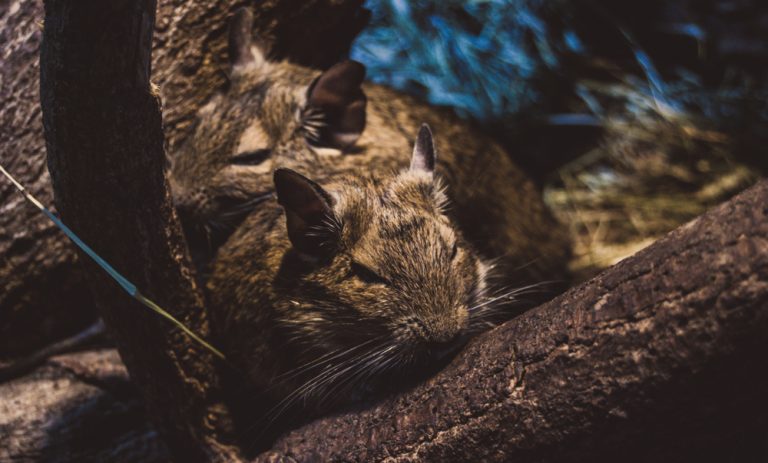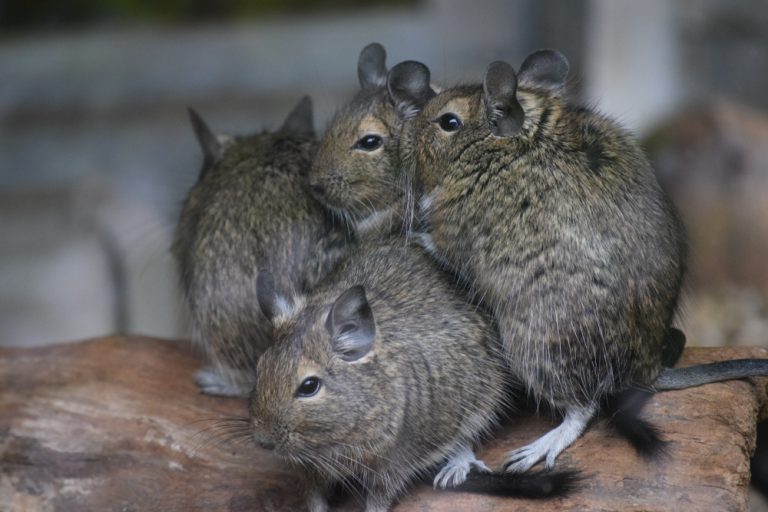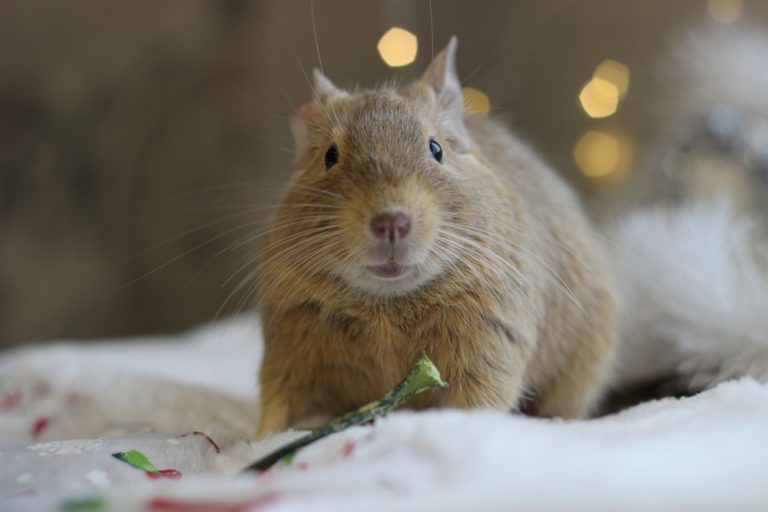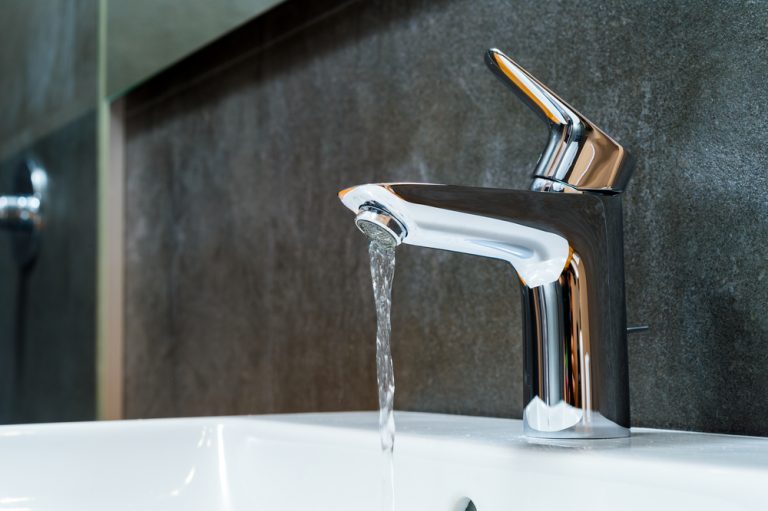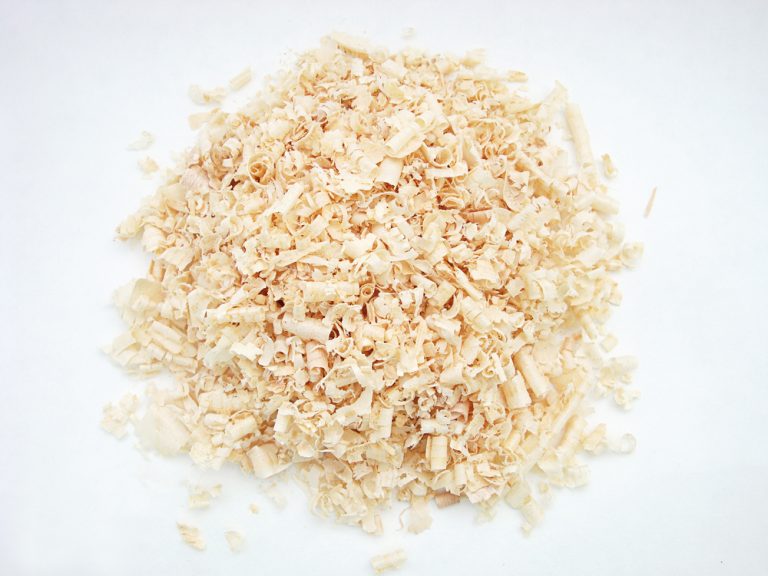Degu Cage Guide: What You Need to Know About Degu Cages
When you get your degus, you’ll need a habitat to keep them in. Degus need large cages and shouldn’t be kept in cages that are meant for hamsters or guinea pigs. Contrary to these pets, degus love to jump and run and will need a lot of space to do this.
A cage is probably the item you’ll spend the most money on. It’s essential but a good cage will cost several hundred dollars. It’s a good idea to know exactly what cage you need so you don’t have to buy another cage after a year or so.
In this article, you’ll learn everything – and I mean everything – there is to know about degu cages. At the end of this article, you’ll know what type of cage to choose, what cage size you should get, and what material your degu cage should be made of. You’ll also get an idea of the perfect cage location in your home. Lastly, I added some great sites for you to find good degu cages that have great quality and are made for degus.
This site contains affiliate links to products we recommend and use ourselves. We may receive a commission for purchases that you make through these links. If you’re interested in learning more about our affiliate links, please visit our (affiliate) disclaimer.
Natural Habitat of Degus
Wild degus are social creatures that work together to create burrows and tunnel networks. Each burrow has chambers that have a distinct function as a toilet area, nesting chamber or storage chamber. Burrows have multiple entries where the degus place sticks, stones, and droppings to mark the territory.
Although degus are known as non-aggressive and friendly pets, they are territorial creatures. A group of degus usually has a territory of roughly 200 square meters that they call their own.
Housing Pet Degus
Degus are used to large territories. The average house size differs from country to country. In the United States, the average house size is around 2,000 square feet. Translated to square meters this is 185. So you’ll have a hard time recreating an entire ecosystem for degus in a home that’s doesn’t even have a floor area of 200 square meters.
Luckily, degus can also be happy if they’re kept in a smaller habitat. I’m getting into the size of the degus home in a few minutes. First, you’ll need to know a little bit about the different housing types there are available for degus.
Cage or vivarium?
Pets can be kept in a cage or in a vivarium. When you think of a cage, you’ll most likely think about a wire cage with horizontal or vertical bars. A vivarium, on the other hand, is less known. Most people know a kind of vivarium, an aquarium (for fish) or a terrarium (for reptiles). But degus can also be kept in a vivarium.
Why a cage is more suitable as a degu house?
If you don’t have a lot of experience housing degus and are not that handy, I would highly advise you to keep your degus in a cage and not in a vivarium.
Why?
There are a number of reasons why a cage is better for housing degus than a vivarium:
- you’ll need good ventilation: degus need good ventilation to not overheat and suffer heatstroke. A vivarium is inferior to a wire cage on this topic. Most vivariums have ventilation that isn’t sufficient for degus. The spacing between the bars of a wire cage, however, provides enough ventilation in the cage.
- degus love different levels in their house: degus are active creatures that need different levels in their homes. Degus are not that suitable for horizontal cages but need to be kept in a vertical cage. Vivariums can be high but you’ll need a lot of adjustments to create different levels. Wire cages are a lot easier to adjust to having different levels and most rodent cages already have at least one extra level.
- escape-proofing the degu house: degus are curious creatures and are also a little bit escape artists. Cages are usually made entirely of metal or stainless steel – which is chew-proof. A vivarium on the other hand often has doors and vents that are made of plastic. Your degus can chew through these plastic materials.
Is a vivarium a no-go as a degu house?
Absolutely not, vivariums can be made in very good and beautiful degu houses but you’ll need to think about a lot more than you would if you would get a cage. Housing degus in a vivarium is more complex and will need more DIY skills. The more knowledgable and handy degu owners can make a custom vivarium for their degus.
(Minimum) Cage Size
A little note before you read further: For convenience, I’ll be talking about cages in the rest of this article but the same guidelines are applicable for a vivarium.
Degus are social animals that live in groups in the wild. If you want to keep your degu happy, you’ll need to keep at least a pair of degus and preferably a small group. Since you’ll usually keep more than one degu in a cage, your cage size should be appropriate for the number of degus you keep.
Cage Size Standards
Degus need a relatively large cage where they can jump and run. The best cage to keep degus in is a vertical cage, just like a birdcage, that has multiple levels. There are a lot of different instances that advise different minimum cage sizes.
To give you an idea of the differences, I gathered a few of them for housing a pair of degus:
| Instance | Length | Width | Height |
| RSPCA | 100 cm | 60 cm | 60 cm |
| German Veterinary Association | 100 cm | 50 cm | 100 cm |
Some instances use a minimum floor area and a minimum height:
| Instance | Floor area | Height |
| Swiss Animal Protection | 2,000 cm² | 200 cm |
| Animal Welfare Regulation | 2,250 cm² | 30 cm |
As you can see there’s a lot of difference in the minimum cage sizes. One thing that all instances have in common, is the bigger the better. Degus have a large territory in nature and if you’ve got enough space in your home, you should get a large cage where your degus can run and jump all they want.
Cumulative Available Running Area (CARA)
A more interesting way to calculate if the cage is large enough for your degus is to calculate the Cumulative Available Running Area (CARA) as mentioned in a forum called Degus International Community.
| Number of degus | Minimum size (cm²) | Minimum size (in²) |
| 2-3 | 18,000 | 2,780 |
| 4 | 22,000 | 3,400 |
| 5 | 26,000 | 4,020 |
| 6 | 30,000 | 4,640 |
As you might have noticed, the minimum cage size in this method is 18,000 cm² and 2,780 in² for a pair or three degus. As soon as you add more degus to your group, you should add 4,000 cm² or 620 in² for each extra degu.
To calculate the CARA you should multiply the length by the depth (width) for each level of the cage. Add up all the obtained values to receive a total CARA. A level that has a CARA less than 3,000 cm² should not be considered in the total calculation of the CARA.
The CARA is not the only important measurement to consider. A cage should always have at least a length of 100 cm. The floor area should also be at least 5,000 cm².
If you want to achieve a decent CARA you’ll not only need enough floor area, but also enough levels. Since an exercise wheel is not only a toy but is also essential for your degus, you’ll need to have at least one level with enough height to place an exercise wheel in. A decent exercise wheel has a minimum diameter of 12 inches (30 cm).
Cage Material
Cages come in all kinds of materials. The most common cage materials are metal, plastic, wood, and glass (vivarium).
Metal and glass cages are suitable for degus although glass cages can overheat fast so you’ll need to provide good ventilation in that case and check the temperature regularly. Plastic cages are not suitable for degus. They will chew through plastic and can get sick doing so. If they can chew through the plastic, they’ll escape and you’ll need a lot of effort to catch these fast critters. Wooden cages can be suitable for degus if the wooden parts are limited to the flooring. Wood is a chewable item but your degus can’t chew through it if the wood is perfectly horizontal, like a floor.
Cage Location
Location is one of the most important things when it comes to property. The same goes for the location of your degu cage. Take the following into consideration when choosing a location for your degu cage.
Exposure to sunlight
Degus are crepuscular and diurnal pets. They are awake during the day with peaks of activity at dawn and dusk. In captivity, degus will adapt to your schedule but they also use the light as a guide for their sleeping habits. Place the cage in a location where the degus experience a normal day/night light cycle.
Never put the cage in direct sunlight! Direct sunlight can heat up the cage fast and your degus might not get out of their nesting boxes and suffer heatstroke.
Temperature
Degus live in a region where temperatures can get really high. But at the times that the temperatures get too high they are less active and will stay in their cooler burrow. If a degu would stay outside he would develop a heatstroke. Degus also can’t stand extreme low temperatures and can suffer from pneumonia.
In captivity, degus can’t really hide in a cool burrow if the temperature is high. In regions with a mild climate, the temperature will seldom be a problem. But it’s still important to know that, when temperatures do get high, your degus need to stay cool. You can do this by relocating them to a cooler location or by using air-conditioning in the room. Just make sure that the cage isn’t located near the air-conditioning system itself.
In the winter, make sure that your degus stay warm. Give them enough nesting material to line up their nesting box. You can also heat up the room to room temperature. As is the case with the air-conditioning and ventilation, don’t place the cage near the heat. This might cause overheating since degus don’t sweat.
The best temperature for your degus is a steady room temperature around 21 degrees Celsius (70 degrees Fahrenheit). They can be kept at temperatures that range from 15 to 25 degrees Celsius (59 to 77 degrees Fahrenheit) but shouldn’t be kept for long periods of time at these temperatures.
Placement
A final important aspect of cage location is the placement itself. You should place the cage:
- on waist level or higher: degus are prey animals and are preyed upon by birds. Their natural instinct is to run when they encounter a predator or bite in extreme cases. Since rodents don’t have good eyesight they might think that you are a bird of prey and get scared. So your degus should always be able to get to a level that’s the same height as yourself.
- away from ventilation, radiators, direct sunlight and cold spots: degus are sensitive creatures and can get a heat stroke when exposed to high temperatures for extended periods. But when the cage is located near a cold spot, they also can get sick and can get pneumonia.
“Bad” cage locations
There are some locations that are more suitable than others to place your degu cage. Here are some “bad” cage locations, although a lot will depend on the particular situation in your home:
- bedroom: degus are most active during the day but when you place a cage in your bedroom it’s possible that they still make noises that wake you up. Besides that, it’s never a good idea to place a cage in a bedroom because it can lead to the development of allergies.
- garage or shed: garages and sheds are usually colder than the rest of the house. Also, exhaust fumes are dangerous for your degus.
The above locations are also less suitable because you’ll not see your degus as much as when you house them in your living room.
Tips and Tricks for Choosing a Good Cage
Now you know what the requirements are for a good cage. But I’ve got a few more tips and tricks for you.
- bar spacing: degus are small rodents and can squirm themselves through small openings. If you get a wire cage, you should make sure that the space between the bars is not larger than 2 cm (0,8 in). Young degus can still fit through bars that are 2 cm but adult degus will not be able to squirm their way through this.
- cage floor: opt for a solid floor made of metal and not a floor made of wire mesh. If the floor is made of wire mesh, your degus will get injured when running on the floor. You can use bedding on the wire mesh, but you should still make sure that there is a solid platform where your degus can rest their feet. If your cage has a mesh floor you can put ceramic tiles on the mesh to prevent injuries.
- secure the cage doors: degus are intelligent and fast creatures. They can escape when the cage door isn’t secured. Also, young children can be tempted to open the door and handle your degus. Handling by young children should always happen under supervision. So, it’s best to use a lock to secure the cage doors.
- double doors: a cage with double doors makes life a lot easier. It’s a lot easier to feed your degus and to clean the cage.
Good Degu Cage Types
With all of the knowledge you’ve gathered at this point, you’ll probably think that it will be very difficult to find a suitable cage for your degus. In fact, you’re probably right and good degu cages are not that easy to find. Most “degu cages” that are sold, are not that suitable for degus and are more suitable for other kinds of rodents, like chinchillas or guinea pigs.
Taking into account the size requirements and cage material the following cage types are suitable for degus:
- birdcages: birdcages, like parrot cage, are usually larger than rodent cages and can be perfect for degus. They do need to be modified to fit in a pair or small group of degus by adding levels and replacing the flooring if it’s made of plastic. Make sure that the spacing between the bars is less than 2 cm (0,8 in). Most bird cages also have vertical bars which make them not suitable for climbing.
- chinchilla cages: a chinchilla cage usually is also suitable for degus provided that the spacing is small enough. Most “degu” cages are in fact chinchilla cages. Make sure that the cage doors are not too small for your degus.
- ferret cages: ferret cages are usually also larger than rodent cages but often have plastic components. If you customize a ferret cage, at least make sure to replace the plastic pieces and, as always, check for bar spacing.
Where to Buy a Good Degu Cage?
Cages can be bought online or in your local pet store. The size of the cage you choose will depend on the number of degus you need to house.
An important note I’ve got to make is that most store-bought cages don’t have a large enough CARA. If you want to achieve the appropriate CARA you’ll need to get an appropriate cage type, securely attach multiple cages together or create your own cage.
Want to Learn More?
If you’re interested in learning more about pocket pets), please read the following articles:
If you’re interested in getting degus as pets you should also definitely read our beginner’s guide to keeping degus as pets and our degu care guide.


